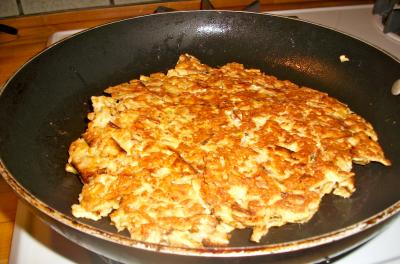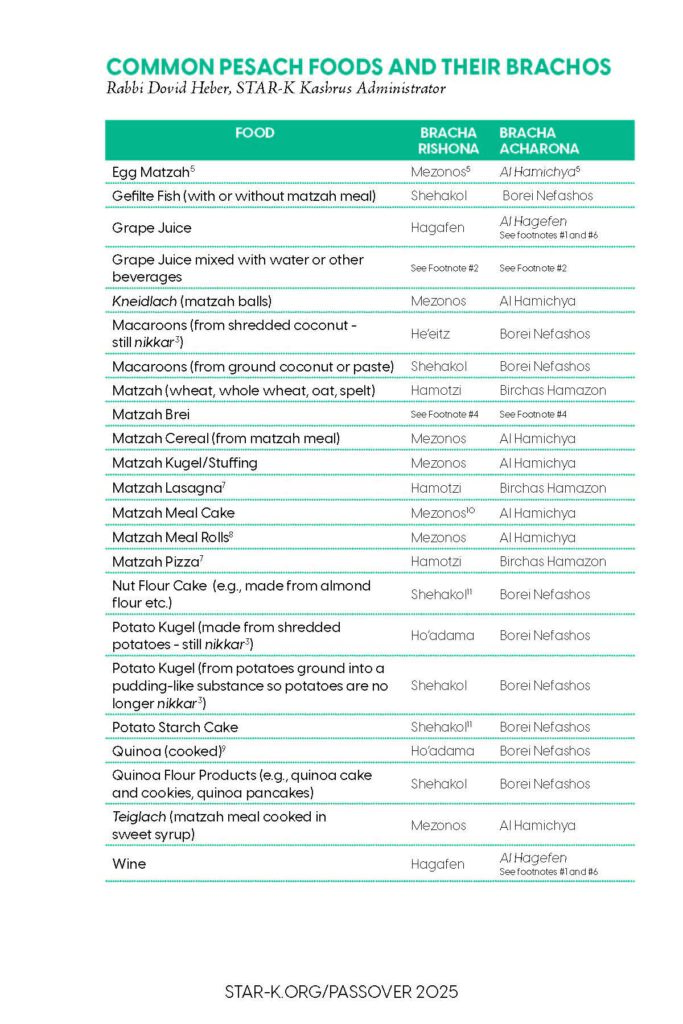
Have you ever taken a bite out of a coconut macaroon and later doubted your choice of bracha? Was it really Ha’eitz or is it Shehakol? And what about matzah brei or matzah lasagna? Do they require washing for a Hamotzi or are they Mezonos? The table below should clear up any confusion.

1. A bracha acharona is recited when drinking at least a revi’is (3.8 fl. oz.) within a 30 second span. If one drank between 1.0 fl. oz. (kezayis according to some opinions) and 3.8 fl. oz. (and cannot drink more) within a 30 second span, a bracha acharona is not recited. However, if one also requires an Al Hamichya or Al Ha’eitz at this time, one can also include Al Hagefen. See Mishnah Berurah [M.B.] 208:82.
2. This depends on the percentage of grape juice. If there is a majority of grape juice (51%), recite Hagefen/Al Hagefen. However, if the mixture is rov water (or another beverage such as apple juice) the bracha depends on various factors. See Rama 202:1, M.B. and Biur Halacha. Consult a rav.
3. Nikkar means it is still noticeable. Typically, shredded coconut or grated potatoes are considered nikkar and the original bracha is retained. However, if finely ground or processed, the original form is no longer nikkar and the bracha is changed to Shehakol. See M.B. 208:37-38.
4. Matzah brei is typically made from matzah that was broken into pieces less than a kezayis. (The fact that they are reformed into a kezayis is irrelevant). The halacha is as follows: If the pieces of matzah were boiled in water, or submerged into a kli rishon off the fire, or the matzah is no longer nikkar (e.g., it was fried in oil with eggs), one recites Mezonos/Al Hamichya. If the matzah was not boiled and the matzah was pan-fried with minimal oil or butter (e.g., an oil spray was used), and the matzah is still nikkar, one recites Hamotzi/Birchas Hamazon. See Shulchan Aruch Orach Chaim [S.A. O.C.] 168:10 and M.B.
5. Egg matzah and matzah ashira may not be eaten on Pesach according to Ashkenazic practice, except by the sick or elderly who cannot eat regular matzah and require egg matzah. Consult your rav. Please note: Even the sick and elderly cannot fulfill the obligation to eat matzah at the Seder with these types of matzos. As noted in the chart, in general, the bracha rishona is Mezonos and the bracha acharona is Al Hamichya. However, if one is kovea seudah on it (e.g., as part of a full meal), recite Hamotzi and Birchas Hamazon. See Rama O.C. 562:4.
6. The bracha acharona on wine and grape juice made in Israel ends with the words “v’al pri gafna” (instead of “v’al pri hagafen”). See Birkei Yosef O.C. 208:58.
7. We assume the pieces of matzah are still nikkar as matzah or at least one piece of matzah remained a kezayis. See S.A. O.C. 168:10 and M.B.
8. We assume that the matzah rolls are made from matzah meal that was put into a kli rishon of water or the “rolls” do not have the texture of bread (i.e., no tzuras hapas). See S.A. O.C. 168:10 and M.B.
9. Quinoa may need to be checked for possible insect infestation. See star-k.org.
10. If matzah meal cake is eaten for dessert at the end of a meal that began with matzah/Hamotzi, no bracha is recited on the cake.
11. If potato starch cake (or any other Shehakol “cake” – e.g., one made from almond flour) is eaten for dessert at the end of a meal that began with matzah/Hamotzi, a Shehakol is recited.

 STAR-D
STAR-D STAR-S
STAR-S